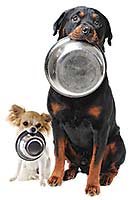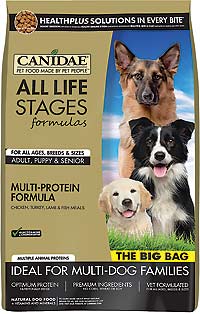At the Moab BARKery we have been getting calls, social media messages and countless articles from differing websites and publications, perhaps even from you, regarding the recent FDA warning that it is investigating a possible link between grain-free diets and dilated cardiomyopathy (DCM) in dogs.
The warning spread at an insane rate through social media and what some would consider legitimate media channels, but unfortunately, it also rapidly got simplified and dumbed down to a ridiculous level and quickly evolved into something like “grain-free foods cause canine heart disease,” or worse statements like “boutique foods might kill your dog”. 
If pet parents are relying on this information being disseminated, then the ensuing panic makes sense, however its important to note that the whole picture is not being represented in these articles and that the FDA is only investigating the issue as a potential association between diets with very specific attributes, not all grain-free diets, and DCM not a cause.
Please note that the FDA warning did not say anything about grain-free diets causing heart problems, though almost all of the blogs, posts and articles in most publications have been saying exactly that. If you read that actual statement from the FDA, you will see that they said there may be a link between some grain-free diets and canine DCM, but there are also many other things going on that may be responsible for an observed rise in cases of canine DCM. Breeding, genetics, vaccine protocols, food ingredient quality and exposure to environmental toxins are all things to also consider when investigating the cause of a rise in canine disease of any kind.
Grain-free diets have gotten inordinately popular, for no apparent reason other than consumers mistakenly equate grain-free as equaling better quality than their grained counterparts. When the first few grain-free dry foods began appearing on the market about 10 years ago, it provided a product that could be fed to dogs that were allergic or intolerant of grains, these dogs are in the minority. 
People who suspected their dog might have an allergy to or intolerance of some grain could try these foods and see for themselves: if their dog improved, got worse or made no difference at all. Lots of people tried grain-free foods and some of them noticed that their dog’s allergy symptoms or digestive problems went away. When you have been dealing with a chronically itchy dog or one with gas that could clear a room, and these symptoms cease, it is like a miracle and they will advocate for the cure, in this case grain-free food. Between the feeding successes of these foods in some dogs, the enthusiasm of the owners of the success-story dogs, grain-free just took off.
So why does the FDA suspect that a grain-free diet contributes to the development of canine heart disease. The dogs in the reports have something in common; they all are eating foods that contain specific ingredients; peas, lentils, potatoes and other legumes. The dogs in the reports ate grain-free foods “as their primary source of nutrition” for months to years. The FDA has not shown how these foods are linked to DCM and they have also not named any specific brands.
More research is needed to determine if the way in which the offending ingredients are being grown. The fertilizers, the chemicals and the growing conditions may all be factors. There is also the potential for some of those chemicals that remain in the product to be taken in by your dog. This could alter your dog’s ability to metabolize potential toxins or chelate important minerals. Feed-grade fillers that are not suitable for human consumption could also play a role. These may be immature, carry imperfections or could be contaminated with mycotoxins, a dangerous mold. They could even been tainted with some of the chemicals used to grow them, like we are seeing with the pervasive presence of glysophates (a toxic herbicide) in our own food system. It is not a simple study; researchers are going to have to consider many variables to get a concrete answer.
The most significant thing to consider in this FDA investigation is that all of the dogs were fed the same food for a period of months or years. Feeding any type of dry dog food every day, all year, for years and years, goes against our longest-standing food recommendation. We have always encouraged owners to switch food regularly, at least several times a year and switch manufacturers, too. More importantly we encourage our customers to incorporate whole fresh food, raw foods and whole food supplements. 
Dry dog food, whether grain-free or not is not good for your dog when fed exclusively. Kibble is cooked and extrusion is the main method used for making kibble. For most kibbles, the manufacturing process requires the food to be heated four times. That means, by the time it hits the bag, virtually all of the nutrition is gone. To put the nutrition back in, vitamins and minerals are added to the food, but these are not real vitamins and minerals, they are synthetic. They are manufactured in a lab and contain a fraction of what is found in naturally occurring vitamins. Many food makers use the same vitamin and mineral premix in all their products, making us worry that any nutrient excess, deficiency, or imbalance would become essentially entrenched in the body of a dog fed an exclusive diet of that company’s foods.
When providing nutritional recommendations for your dog, we suggest that you…
Feed a variety of products, rotating both among and between several manufacturers of products, for nutritional balance over time, and to avoid problems caused by long-term exposure to any formulation problems or nutritional imbalances/excesses/inadequacies in your dog’s diet.
Feed the best food you can afford and that your dog does well on. This doesn’t mean spend the most that’s possible; if your dog does great on mid-range foods, great! But super cheap food should be avoided. The difference in the ingredients of cheap foods versus mid-range foods is staggering.
Feed grain-free foods only for good reason (dog intolerant of/allergic to multiple grains) not because you equate grain-free with high quality. There are many high quality grain friendly foods available on the market and at the Moab Barkery. We recommend Canidae All Life Stages, FirstMate Grain Friendly and Nutri Source.
DO READ ingredient labels. You should recognize most of the foods in the food; if things are weird, and only sound sort of food-like, they are likely highly processed food fractions. You don’t want to see a lot of those. If the front of the label says the food is “chicken and rice” you had better see chicken and rice high up on the ingredient label, not buried four ingredients back below chicken by-product meal, corn, wheat, beet pulp and pea protein.
Incorporate raw and whole foods as part of your dog’s regular diet. There is already plenty of research about the drawbacks of feeding a highly processed, shelf stable diet as your dog’s only nutrition. Your dog’s diet should keep them healthy, not lead to further damage and disease.
|